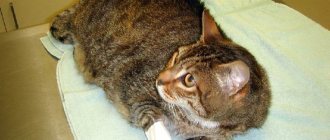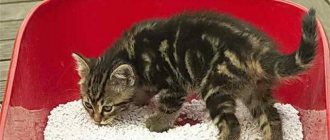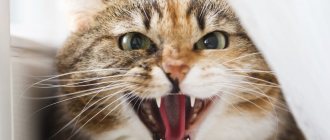Why does a cat limp on its hind leg without visible damage?
Most often, cat lameness is caused by a physical injury, but some diseases and disorders can also cause pain, causing the cat to stop walking.
Visible and invisible reasons:
- fracture (closed or open);
- dislocation;
- sprained ligaments;
- improperly formed joints;
- arthrosis of the joints;
- arthritis;
- injury;
- lower back injuries;
- long claws;
- osteosarcoma (oncology), etc.
Prevention of lameness
To prevent lameness due to insufficiency of vitamins and microelements, the development of arthritis, and arthrosis, the cat’s diet must be balanced. If you use dry food, then only high-quality industrial food. Before purchasing, you should carefully read the ingredients. It is necessary to limit the consumption of canned food, fatty foods, flour products, and also add more boiled vegetables.
Only a veterinarian can prescribe vitamins. Many four-legged felines are allergic to them.
Whatever the cause of lameness, it causes discomfort and pain to the patient. Trying to treat it yourself means wasting time. What if this is a serious disease that requires urgent surgical intervention? It is not at all difficult to show your pet to a specialist, thereby preserving his health, and in some cases, his life.
Lameness in a cat can be a sign not only of physical injury, but also of a number of serious diseases. A caring owner will definitely try to help the pet: provide first aid or take it to the veterinarian for examination. The article describes in detail how to behave if your cat is limping on its hind leg without visible damage, and how to help the animal so as not to cause even more harm.
Why might a cat shake its paw or pull it back?
Sometimes cat/cat breeders notice that the pet is shaking its paw or pulling it back.
This can happen for several reasons:
- Ticks. The parasites attach themselves to the soft pad on the paw and burrow into the flesh. This causes severe discomfort to the animal, so the cat shakes the limb to relieve the pain. The pet owner can detect the tick by visually inspecting the paw and remove it.
- Worms . The appearance of helminthic parasites in an animal’s body can be noticed by the following symptoms: the cat is constantly restless, shakes one or the other paw, and sometimes eats poorly. Worm eggs can also enter the human body when he caresses or kisses a pet, so medical consultation is extremely important here.
- Inconvenience after sterilization. After sterilization, a special blanket is put on the animal to prevent licking the healing scar. It usually bothers cats, and they try to remove it in every possible way. At the same time, they can shake their hind legs.
- Scotch tape, glue, chewing gum, splinter. Cats, especially those who walk outside, often catch pieces of adhesive tape, chewing gum, resin, splinters, etc. on their paws. Sensing a foreign object on the pad, the pet shakes the limb in an attempt to get rid of it.
Be sure to read:
What causes growths on the pads of cats' front or hind paws?
Prevention
You can prevent lameness in your cat by minimizing the likelihood of injury. The main preventive measures to prevent a cat from limping are :
- monitoring what is happening to the animal while walking down the street;
- securely closing windows to protect your pet from falling out;
- adequate feeding – proper nutrition provides the animal with sufficient bone strength and tendon elasticity;
- Be careful when closing the doors so as not to slam the cat.
If a cat is limping, you must definitely understand what happened to him.
Lameness in cats does not appear just like that; there are always reasons that cause it. If a pet has a slight limp, and this defect goes away after 1-2 days, he could have hurt her. This often happens in sedentary and overweight cats. When the animal does not step on its hind paw at all, it must be carefully examined for damage. The cat's reaction to the examination will prompt further actions. Severe pain in response to any touch will force her to become aggressive. The cat will begin to struggle, bite, and meow loudly. This means that serious injuries, including fractures, or dangerous diseases cannot be ruled out. She needs to be shown to a veterinarian.
What to do if your cat is limping with fractures and bruises
A cat's paw bruise is not uncommon, especially in young cats. During play, kittens actively run and jump, which can result in injury. The bruise does not threaten the life of the animal, but requires treatment to avoid inflammation.
Fractures in cats are a serious injury that threatens the health and life of the pet.
You cannot do without medical help here.
Fractures and bruises: how to recognize and what to do
The first sign of damage is that the animal holds the affected paw up and does not step on it. If it occurs occasionally, he tries to transfer the body weight to a healthy limb as soon as possible. A bruise can be identified by the following symptoms:
- hematoma in the injured area;
- swollen paw;
- impaired gait with lameness;
- absence of skin wounds;
- absence of displaced joints;
- local temperature increase;
- constant licking of the sore spot (the animal massages the paw with its tongue, accelerating the resorption of the hematoma);
- aggressive behavior when the owner tries to touch the damaged limb.
Fractures have their own distinctive features:
- swollen paw along the entire length, and not just at the site of injury;
- when palpating (feeling) the paw, a displacement of the joints or bones is felt;
- the animal does not attempt to step on the limb;
- due to severe pain, the pet constantly meows;
- the structure of the paw is damaged.
If an animal is bruised, you must first calm it down by picking it up and gently stroking it for several minutes. Then apply cold to the bruised area - a cloth in which ice is wrapped or a towel soaked in cold water. You need to apply it for 1 minute, then take a break for half a minute, and then repeat the procedure again. This must be done for 15 minutes.
A couple of hours after injury, you can do an alcohol rub. You should not put too much pressure on the sore spot - this will cause anxiety and stress in the cat. An alcohol compress can be applied to a calm animal, which effectively relieves swelling and pain.
Be sure to read:
A cat's teeth are falling out: physiological and pathological reasons, what to do, prevention
In case of a fracture, it is necessary to provide maximum rest to the animal, place it in a carrier or take it to a bed. The diseased limb must be fixed to avoid displacement of bones and joints, and then urgently taken to a veterinary clinic.
Important! Never set a broken bone yourself!
If your pet is suspected of having a spinal fracture, you should move it as carefully as possible onto a rug or blanket, take it to the car and take it to the veterinarian as soon as possible. Any displacement of the vertebrae can result in damage to the spinal cord. If the jaw is broken, it is necessary to put a muzzle on the cat - this will protect it from shifting bone fragments that threaten to rupture the soft tissues.
Patella luxation
Patella, or dislocation of the stifle, is uncommon in cats. The main reasons for its appearance are severe injuries or genetic abnormalities. The disease occurs suddenly: the animal experiences severe pain, cannot move normally, limps, and reacts to stroking with hissing and aggressive behavior. The pet constantly meows, he is scared. In such a situation, they act immediately - the animal is urgently hospitalized.
Back or brain injury and their consequences
Cats are by nature very active and curious. These qualities often play a cruel joke on them. While examining unfamiliar objects, they can receive various injuries: open injuries to the skin and soft tissues, dislocations, sprains and torn ligaments, bone fractures and joint injuries. If your four-legged pet suddenly becomes lame, the cause of the lameness probably lies in one of the listed problems.
Fights with relatives and contact with sharp objects can lead to damage to soft tissues. This condition, in addition to lameness, is accompanied by bleeding of varying degrees of intensity, redness of surrounding tissues, and acute pain. Traumatic swelling often occurs, which over time turns into purulent inflammation. The appearance of pus poses the greatest danger.
If the wound is deep and extensive, surgery is required. Injuries received within a few hours before contacting a veterinarian are disinfected and closed with a blind suture. If more time has passed since the injury or there are signs of wound infection, treatment includes the use of antibacterial, anti-inflammatory and analgesic veterinary medications.
If you notice that your pet is pressing its front or back paw, you need to examine it. If there is a wound, it should be treated with any available antiseptic and try to stop the bleeding yourself, and then take the animal to the veterinary clinic.
The cat has a swollen paw and is limping: what to do?
Unfortunately, more severe injuries resulting from cats falling from a great height (from a balcony, roof) are fraught with bruises, concussion of the brain and spinal cord with subsequent neurological disorders. In addition, they may be accompanied by numerous fractures of the musculoskeletal system.
For your information! A strong blow to the head leads to the destruction of brain cells, and the hypothalamus and brain stem may be damaged. In especially severe cases, cerebral hemorrhages and tissue necrosis occur.
When the spinal cord is contused, a disruption in the functioning of the musculoskeletal system occurs, the animal limps or completely loses the ability to move. Vomiting occurs, the pupils often have different sizes, and they react poorly or not at all to light. The cat begins to spontaneously shake its limbs. The head may fall back, and the pet may lose consciousness or fall into a coma.
Important! The cat's symptoms and behavior depend on how severely the animal is injured. In severe forms with rupture of the spinal cord membranes, the sensitivity of the limbs and tail is completely lost.
If the cat is unconscious or in shock, under no circumstances should you shake it or apply ammonia to its nose. You need to make sure that the tongue is not stuck and take it to the veterinarian in your arms. Only a specialist can assess the degree of concussion. Depending on the situation, he will give the necessary injections of antibiotics and sedatives.
We invite you to familiarize yourself with the Colors and breeds of decorative ferrets
The presence of serious diseases that cause lameness can only be detected by a veterinarian
Unfortunately, more severe injuries resulting from cats falling from a great height (from a balcony, roof) are fraught with bruises, concussion of the brain and spinal cord with subsequent neurological disorders. In addition, they may be accompanied by numerous fractures of the musculoskeletal system.
For your information! A strong blow to the head leads to the destruction of brain cells, and the hypothalamus and brain stem may be damaged. In especially severe cases, cerebral hemorrhages and tissue necrosis occur.
When the spinal cord is contused, a disruption in the functioning of the musculoskeletal system occurs, the animal limps or completely loses the ability to move. Vomiting occurs, the pupils often have different sizes, and they react poorly or not at all to light. The cat begins to spontaneously shake its limbs. The head may fall back, and the pet may lose consciousness or fall into a coma.
Important! The cat's symptoms and behavior depend on how severely the animal is injured. In severe forms with rupture of the spinal cord membranes, the sensitivity of the limbs and tail is completely lost.
If the cat is unconscious or in shock, under no circumstances should you shake it or apply ammonia to its nose. You need to make sure that the tongue is not stuck and take it to the veterinarian in your arms. Only a specialist can assess the degree of concussion. Depending on the situation, he will give the necessary injections of antibiotics and sedatives.
The presence of serious diseases that cause lameness can only be detected by a veterinarian
Diseases of the joints and bones
Joint and bone diseases appear in cats, as a rule, at 7-8 years of age - these are the first signs of aging. However, young individuals often develop ailments, many of which are transmitted genetically. Common diseases of the joints and bones of felines include arthrosis and arthritis, osteochondrosis, traumatic arthrosis, osteomyelitis, etc.
Arthrosis
Arthrosis is a non-inflammatory chronic disease. It is asymptomatic for a long time - degenerative reformations in soft tissues, bones and cartilage develop gradually. One of the common causes is a congenital defect of the anatomical structure of the animal. Mostly adults are affected, but sometimes the disease also affects young pets.
Be sure to read:
Interpretation of blood tests in cats: features of the procedure, types, main indicators, norms
Traumatic arthrosis
Traumatic arthrosis is caused by injuries received in youth. Bruises and dislocations that go unnoticed by the owner with age lead to incorrect alignment of bones, cartilage and soft tissues. Often the cause is damage to the lumbar region. This usually happens when landing incorrectly from a height, being hit on the back with a stick, or fighting with dogs. Pinched nerve endings at such a moment lead to severe lameness and discomfort.
First aid for a cat
If you notice lameness in your pet, immediately identify the cause of the problem. If the wound is open, you need to disinfect it by removing the hair around the injury and rinsing the lesion with a solution of furatsilin. After this, apply a sterile bandage and take it to the veterinarian.
In case of a fracture, dislocation, or sprain, immobilize the animal as much as possible, ensuring complete rest, injecting an anesthetic and urgently calling a doctor.
Avoid self-medication! At the clinic, the doctor will take an x-ray and make a diagnosis. If necessary, a fixative bandage is applied; in difficult situations, a splint or plaster cast is used. The animal is given anti-inflammatory drugs and antibiotics.
Arthritis treatment
Therapy for arthritis involves the use of antibiotics, as well as dietary supplements, such as chondroitin or glucosamine. The pet is also advised to take painkillers and fish oil. For arthritis, the doctor prescribes a light massage, the most comfortable conditions for the sick animal, and a diet.
Medications include anti-inflammatory (if necessary) and decongestant drugs. Therapy using a Minin lamp is useful for cats. Severe, neglected situations often have a disastrous outcome: the pet suffers from severe pain, and the injured limb is sometimes paralyzed.










